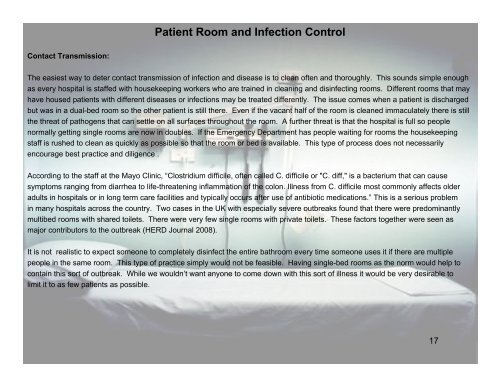The Patient Room: what is the ideal solution? - Cornell University
The Patient Room: what is the ideal solution? - Cornell University
The Patient Room: what is the ideal solution? - Cornell University
Create successful ePaper yourself
Turn your PDF publications into a flip-book with our unique Google optimized e-Paper software.
Contact Transm<strong>is</strong>sion:<br />
<strong>Patient</strong> <strong>Room</strong> and Infection Control<br />
<strong>The</strong> easiest way to deter contact transm<strong>is</strong>sion of infection and d<strong>is</strong>ease <strong>is</strong> to clean often and thoroughly. Th<strong>is</strong> sounds simple enough<br />
as every hospital <strong>is</strong> staffed with housekeeping workers who are trained in cleaning and d<strong>is</strong>infecting rooms. Different rooms that may<br />
have housed patients with different d<strong>is</strong>eases or infections may be treated differently. <strong>The</strong> <strong>is</strong>sue comes when a patient <strong>is</strong> d<strong>is</strong>charged<br />
but was in a dual-bed room so <strong>the</strong> o<strong>the</strong>r patient <strong>is</strong> still <strong>the</strong>re. Even if <strong>the</strong> vacant half of <strong>the</strong> room <strong>is</strong> cleaned immaculately <strong>the</strong>re <strong>is</strong> still<br />
<strong>the</strong> threat of pathogens that can settle on all surfaces throughout <strong>the</strong> room. A fur<strong>the</strong>r threat <strong>is</strong> that <strong>the</strong> hospital <strong>is</strong> full so people<br />
normally getting single rooms are now in doubles. If <strong>the</strong> Emergency Department has people waiting for rooms <strong>the</strong> housekeeping<br />
staff <strong>is</strong> rushed to clean as quickly as possible so that <strong>the</strong> room or bed <strong>is</strong> available. Th<strong>is</strong> type of process does not necessarily<br />
encourage best practice and diligence .<br />
According to <strong>the</strong> staff at <strong>the</strong> Mayo Clinic, “Clostridium difficile, often called C. difficile or "C. diff," <strong>is</strong> a bacterium that can cause<br />
symptoms ranging from diarrhea to life-threatening inflammation of <strong>the</strong> colon. Illness from C. difficile most commonly affects older<br />
adults in hospitals or in long term care facilities and typically occurs after use of antibiotic medications.” Th<strong>is</strong> <strong>is</strong> a serious problem<br />
in many hospitals across <strong>the</strong> country. Two cases in <strong>the</strong> UK with especially severe outbreaks found that <strong>the</strong>re were predominantly<br />
multibed rooms with shared toilets. <strong>The</strong>re were very few single rooms with private toilets. <strong>The</strong>se factors toge<strong>the</strong>r were seen as<br />
major contributors to <strong>the</strong> outbreak (HERD Journal 2008).<br />
It <strong>is</strong> not real<strong>is</strong>tic to expect someone to completely d<strong>is</strong>infect <strong>the</strong> entire bathroom every time someone uses it if <strong>the</strong>re are multiple<br />
people in <strong>the</strong> same room. Th<strong>is</strong> type of practice simply would not be feasible. Having single-bed rooms as <strong>the</strong> norm would help to<br />
contain th<strong>is</strong> sort of outbreak. While we wouldn’t want anyone to come down with th<strong>is</strong> sort of illness it would be very desirable to<br />
limit it to as few patients as possible.<br />
17







